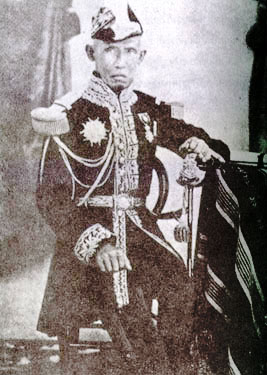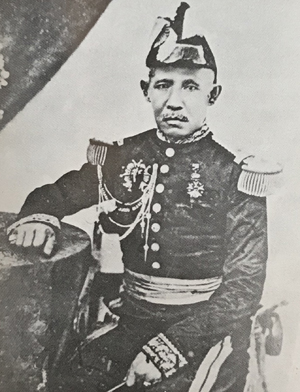|
|||||||||||||
Second King Pinklao of Siam 1808-1865 |
HM SECOND KING PINKLAO OF SIAM Second King Pinklao was born Prince Isares Juthamanee in 1808, the 27th son, or 50th child of HM King Rama II, and was the 3rd full Royal son (having a Royal mother as well). At the time of his birth, his grandfather, King Rama I, still reigned. During the reign of his elder half-brother, King Rama III, he was elevated to the title of The Prince Issares Rangsan (Kromma Kun Issares Rangsan), and had positioned himself in the Royal Navy. He was also the younger brother of King Rama IV. He became the Second King of Siam in 1851, just after his elder brother, Prince Monkut, was crowned King Rama IV of the Chakri Dynasty. The Second King had 63 children, but only 30 survived to adulthood; 16 of them were sons, and 14 daughters. The King became ill in 1861, and never regained his full strength back. He passed away on 7 January 1865, at 57 years of age. There are 11 Royal Houses descended from the Second King. _________________ Related links: A Man of Arts and Sciences, Bangkok Post, 7 Aug 2014 |
||||||||||||
|
|||||||||||||
THE MAHA UPARAJA Siam up until the reign of King Chulalongkorn did not have crown princes as heirs to the throne. Instead, there was the title of Maha Uparaja Krom Phra Rajawang Bavorn, known as the front palace, who acted as deputy to a king, as well as Heir to the Throne. This title was always held by one of the king's brothers, of his own choosing. In actual fact, all the Maha Uparajas died before the king, so the eldest son of the King and Queen became the next king. Another fact was that, King Rama II died without having chosen his heir, so it was the Royal Council who chose Prince Jesadabodhin as the next king, who became King Rama III. This was strange to some as the prince, although the eldest child, was not of full royal blood, as his mother was non-royal and held the rank of Chao Chom Manda. But what he lacked in lineage, he made up with his work experience, having worked closely with King Rama II. He was also said to be a very wise man, which was ultimately proven with his reign. When King Rama III died, leaving the decision up to the Royal Council to elect the next king, Prince Monkut was then rightfully chosen. By that time, King Mongkut has been a monk most of his adult life, but has also gained insights from his travels around Siam, as well as having met ordinary people both Siamese and foreign, and has learned and seen much. |
|||||||||||||
 |
THE SECOND KING OF SIAM On becoming king, King Monkut said that he would like to appoint his younger brother, Prince Isares Juthamanee as the head of the Front Palace, making him the next Maha Uparaja. But, he would also like to bestow on his brother a title that was more important than any Maha Uparajas in the past. He elevated his brother to the rank of Second King with equal rights to that of the king, and who went by the name of "Phra Bat Somdetch Phra Pinklao Chao Yoo Hua," or His Majesty Second King Pinklao of Siam. One can only speculate to why King Rama IV decided to appoint his brother as the Second King. Many believed that it was due to astrological reasons. The people of Siam, then and now, believe that their astrological signs point them in the direction that their lives will take. For King Mongkut, it was believed that the energy surrounding his brother was so great, that if he did not become of equal ranking to himself, there would be danger to the throne and kingdom. So, the king, who was well versed in astrology and astronomy, created a second king so that their energies would not clash. This is an explanation that could be quite extraordinary for some, but it is a belief of a culture, which makes things a little more interesting. Another reason could be that the King needed someone that he could really trust by his side. Traditionally, the Ruling Princes of the Front Palace would just be a "spare," but Prince Isares had all the right makings of a king. While King Mongkut was in the monkhood, his brother was involved with the Royal Navy, and fought in battles with neighbouring countries, so his knowledge would have been most valuable in running the kingdom. He was also well versed in many foreign languages, and could therefore receive foreign guests with ease. It was also at that time that Western powers were eying to colonise Siam, and to say as-a matter-of-factly, two heads are better than one. |
||||||||||||
Above: The Second King's letter to Sir John Bowring, from the book "The Kingdom and People of Siam", by Sir John Bowring |
|||||||||||||
The Prince Bovornvijaya Jarn 1838 - 1885 |
THE LAST MAHA UPARAJA After the Second King's death, his eldest son, HRH Prince Yod Yingyos, Prince Bavornvijaya Jarn, was created the next Krom Phra Rajawang Bavorn, who became the last Maha Uparaja of the Front Palace. Prince Yod Yingyos was born on 6 September 1838, eldest son of Second King Pinklao. He was named "George Washington" after the President of the United States. As Siamese could not pronounce "George" rightly, and it became "Yod". King Rama IV gave the official name to his nephew as HRH Prince Yod Yingyos Bovorn Rachoros Ratana Rajakumar. After the death of the Second King, the prince was then made "The Prince (Krom Meun) Bavornvijaya Jarn" in 1867, but was not elevated to the rank of Maha Uparaja. Internal politics played a large part at that time. A day before King Mongkut's death, while he was gravely ill, the powerful Chao Praya Sri Suriyawonge (Chuang) of the mighty Bunnag Clan called a meeting of the Royal Council which finally appointed Prince Yod as Maha Uparaja, with the English title of Second King. This was in fact not quite right, as such appointment could have been made by the king only, and not by a Royal Council nor a Statesman. Nevetheless, it was done. King Mongkut died the following day, and Prince Chulalongkorn, the king's eldest full-royal son became King Rama V of the Chakri Dynasty, with the elder Maha Uparaja as Heir and Second King at the same time. As Prince Chulalongkorn was not yet of age to rule, Chao Praya Sri Suriyawongse became Head of the Regency Council and pretty much ruled Siam for a while. Looking back, Siam's internal politics then was quite dangerous. Prince Yod Yingyos was a well learned man, but was also pretty much under the thumb of the Regency Council. |
||||||||||||
|
|||||||||||||
MAHA UPARAJA NO MORE After Prince Bovornvijaya Jarn's death in 1885, King Rama V, who has since came to the Throne and held all the absolute power, abolished the title of Maha Uparaja and created the title of Crown Prince, as direct Heir to the Throne. Many assumed the reasons for abolishing the title of Maha Uparaja, and the introduction of the new title of Crown Prince. One reason was that King Rama V had contacts with the Western Monarchs and adopted their way of passing on the crown. Another reason, and a more poignant one, was because of the political problems that happened at the beginning of his reign, involving the front palace of the Maha Uparaja, the British Consul, and the King's close companion. The incident was known as the Front Palace Upheavel, which resulted in the banishment of many members of the Royal Family who sided with the Front Palace to overthrow the king. They found refuge in neighbouring Cambodia. |
|||||||||||||
THE NEW TITLE OF CROWN PRINCE The first crown prince of Thailand was HRH Prince Maha Vajirunhis, the eldest son of the king whose mother was of royal blood. After the first crown prince's premature death during King Rama V's reign, the king appointed HRH Prince Maha Vajiravudh, his next eldest son of full royal blood, as the second crown prince of Siam. Thus, the first crown prince of Siam was never a king. Since then, Kings Rama VI, VII, and VIII did not have male heirs, the third crown prince in Thai history has been the present King Maha Vijiralongkorn (Rama X), the only male heir of King Bhumibol Adulyadej (Rama IX). |
|||||||||||||
| _________________ | |||||||||||||
Note: There was a mention that King Kalakaua, the last king of Hawaii met with the last Maha Uparaja during his visit to Siam in 1881, and thought that the Maha Uparaja was a well educated person, who spoke English fluently. It was also noted that the Siamese dressed elaborately but without shoes - just bare legs and feet! It was certainly the custom of the day, and I guess that the photograph of Prince Yod Yingyos above, with the feet cut off, could be because they were bare! Please also note that the spellings are sometimes different from page to page as there are no fixed way of spelling in the English form. Prince Juthamanee is sometimes written Chutamanee, while the first is how it is actually pronounced, and the second is probably how it should look in English. Bovorn vs Bavorn - quite the same really, except that the first is also how it is actually pronounced, but sometimes the second version of pronunciation is used as well. |
|||||||||||||
| Updated 23 May 2021 | |||||||||||||











